
After 27 hours of flying and waiting we finally arrived in Tokyo. We made our way from the airport and wandered out into the night to find some food and drink. We happily fell into a small yakitori place nearby and as we munched on tasty skewers and edamame and sipped our cold beer we knew we were back. Our Akihabara room is compact but still complete with all that’s needed- pajamas included! I think they look like prison uniforms but it’s the thought.

A little rain would not slow us down and we set off for Roppongi, Tokyo. After a challenging morning trying to understand Tokyo’s incredibly complex train system we found our way to some great architecture and wonderful art too. The National Art Center was a joy to explore with a variety of art in a Kisho Kurikawa designed building from 2007. Oddly came upon a painting featuring the Bengals and our neighbor Jonah Williams! So strange. After a fabulous ramen lunch, we followed up with a visit to the 21_21 Design Center by Tadao Ando. A unique exhibit on materials was set in an equally unique Ando building also from 2007. We capped our day at Hitachino’s local brew pub with good beer, lite bites, a friendly chat with some Brits. Not a lot of bars in the US offer octopus salad with your beer.


A painting not a photo.





Last October day in Tokyo before we head to Sapporo. After a stressful exercise in securing seats on the train to Hakodate for the next day, we went to Ueno-koen - or park- to relax. The area is chocked full of major museums which were oddly closed for reasons unknown. The park was lovely though and the weather was beautiful. A large lake at one end of the park was filled with giant lotus plants on their last legs, but amazing to see. Finished the day with a Japanese craft beer in an 8th floor bar atop an enormous department store selling nearly everything imaginable. Dinner at an izakaya where English was not to be found was entertaining. The sake helped.







Arrived by Shinkansen at Hakodate in Hokkaido. Once a major shipping center for Japan- one of the first opened to foreign trade- now with a lesser role and laid back feel. The varied architecture reflects the history of foreign traders and their influence. The quiet streets and small shops are a stark contrast from the Tokyo neighborhood we just left. Had a great omakase sushi dinner where we were served seafood rarely served raw in the US like squid, shrimp and crab and ones I’ve never had like abalone. Viewed the city at night from Mount Hakodate -accessed via ropeway. Finished the evening in a tiny craft beer bar and a cocktail bar/garage. What a funny place.









The search for breakfast in Hakodate proved far more difficult than expected. The pancake shop and pastry store we had seen the day before didn’t open until 11. The morning market was filled with early diners but bowls of salmon roe or whole shrimp wasn’t exactly what we were looking for at 9am. After coffee and toast in the train station we were off to Sapporo. The train took over 3 hours and much of the trip wound along the coasts. \240Little fishing villages and farming communities filled the land between stations. Arriving in Sapporo late afternoon we found a pleasant, relaxed city with parks and green spaces throughout. We wandered about the restaurant filled area south of the hotel and finally chose a fabulous Yakitori place. Using our translator app we ordered a variety of skewers including the “Ippei original” which turned out to be skewered quail eggs toasted over the coals. We had to eat these shells and all. The shishito peppers were so good we ordered 4 more skewers. The sake made it all even better of course.

Odori park in Sapporo

Train from Hakodate



Beautiful day in Sapporo! Checked out the much beloved Clock Tower which was built in 1878 of which much boasting is made of the amazing clock mechanism. We soon learned it was made in Boston! Also, the students that used to attend class in the building when it was a university were taught in English by Americans. Small world. We moved on the Hokkaido University’s botanic garden which was a lovely way to spend a sunny day. After lunch we found our way back to Sapporo brewery for a tour and tasting. While they don’t brew in this location anymore, the historic campus is beautiful and well maintained. Dinner took us to a yococho -or Japanese alleyway-for ramen, where every little shop had space for 6 to 8 customers. We slipped into one, ordered and paid at the machine, and squeezed into counter seats. Delicious!





Sapporo beer poster from early 1900’s




Another nice day in Sapporo! We made our way to Mt Moiwa where we boarded a ropeway (or gondola) and transferred to a mini cable car for the last leg of the trip up. Summit is around 1,750 feet and provided views of Sapporo all the way out to the ocean. Hiking down could have been an option but with bears and steep trails as a possibility we walked only part way down. Lunch began our seafood day as we munched on Takoyaki at a popular counter spot. Strolled about and found what may be Japan’s smallest bar with standing room for 2- although we opted for the table outside. Dinner at a robatayaki continued our seafood day with mackerel, scallops, whelk and more. All good.







Arrived in Korea late in the day after a Korean flight with tasty food. Good indication of good food to come. Wandered out into the evening for food and drink to find the nearby street filled with diners and food stands. Young crowd ordering all sorts of things we didn’t recognize. Ventured into Ikseondong Village, a maze-like neighborhood of old hanok homes that have been renovated into bars, restaurants and shops. Mostly upscale, but covering everything imaginable. Found a small place and settled in for some spicy toekboki and mandans. Great start to our Korean food experience.

Seoul’s international terminal



Ikeseondong

Toekbokki
Started our day at the biggest of Seoul’s five palaces, Gyeongbokgung, where we arrived at the main gate in time for the changing of the guard-colorful pageantry in a huge, barren courtyard. The many palace buildings are enormous but sadly mostly reconstructed after being destroyed by the Japanese. Our route continued through cultural areas and old hanok neighborhoods before we stopped for lunch. Made our way on to a second nearby palace of nearly equal size and grandeur as the first but with trees, ponds, and large landscaped areas. All good, but we reached our palace limit.







We loaded up on some snack items before heading off by train to Bukhansan National Park. This mountainous park is only a short trip from Seoul and much visited by Koreans who all seem to love hiking. There are numerous granite peaks, streams, forests, temples, gates, and an old fortress dating back to 132AD. Although much confused by the trail map, with some help from locals we found our way up to the top of Mount Wonhyolbong. The trail was mostly large rounded rocks which at times became steep enough to nearly climb hand and foot. At the summit the trail turned to a huge granite rock with rope handrails and steps cut into the stone. Wonderful views and nice people along the way too. We were definitely limping a bit by the time we returned.







The contrasts of the day were many starting with the restored Huenginjimun gate and ancient (1396) walls of the old city close by to Zaha Hadid’s DDP- a bizarre, serpentine shaped museum built in 2011. Had lunch at a noodle stand in Gwangjang Market checking out the stall nearby made famous by the Netflix documentary on street food. The line for her famed noodles was too long and the kimchi dumplings nearby were delicious as well. Wandered back along the Cheonggyecheon Street canal with beautiful plantings and pathways set well below the busy street level. The channel doubles as flood relief in heavy rains and provides tranquil green space in good weather.










First gloomy day since arriving in Japan, but the rain stopped before we even left the hotel. Had a ridiculous breakfast at a cute cafe and then took trains to the National Museum of Korea. Grand place with huge galleries covering Korea’s long history from early man to present day. Made our way to Seoul City Hall to find a strange but interesting building with a 9 story atrium hanging with plants and odd sculptures. The lawn in front was filled with comfy seating and stands with books encouraging everyone to relax and read. Fun day of art and architecture and some Korean barbecue too.
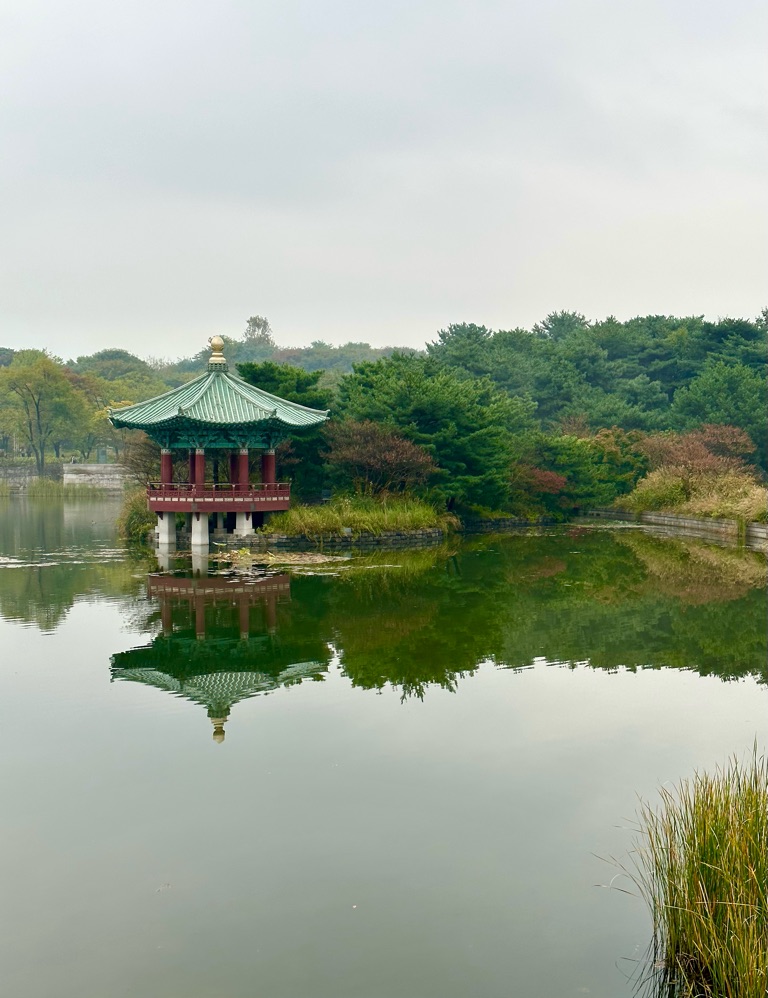


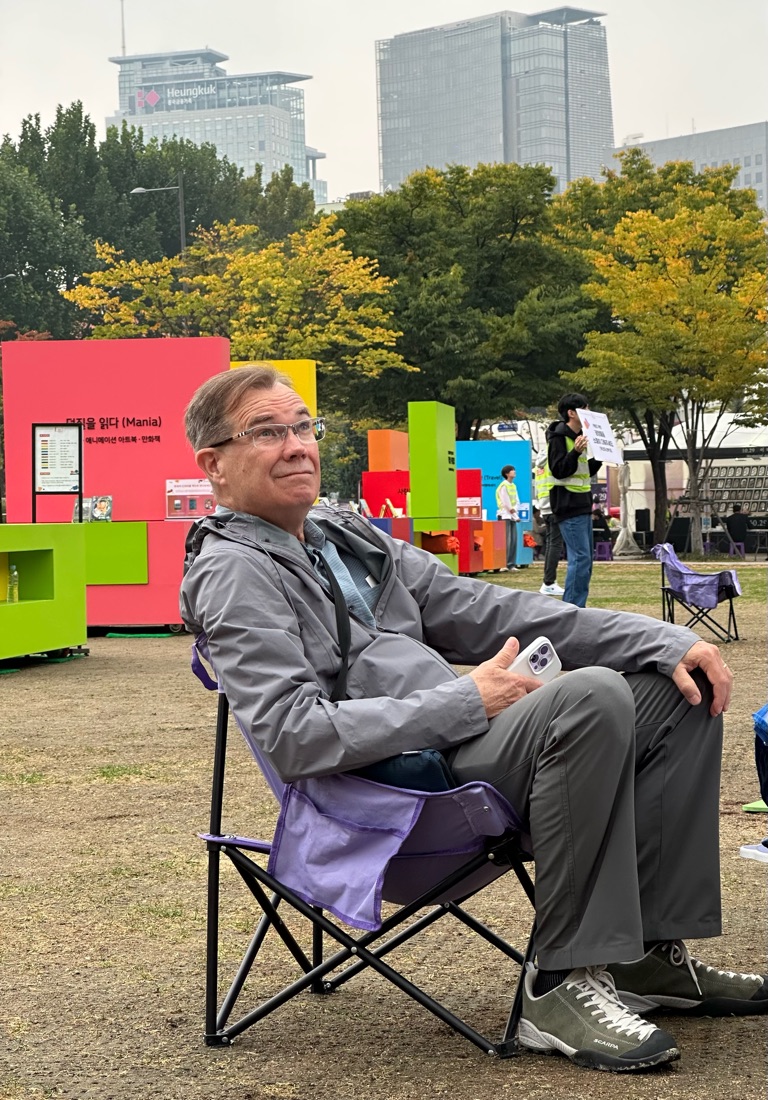




Arrived inJeonju late afternoon. The path to the guest house wound down narrow alleyways to a traditional hanok in the old hanok village. The room itself is an \240experience. No furniture except for a futon and a pile of bed covers. The mini-fridge provides the only usable surface above the floor. Shoes must be left outside of course, and the room locks from the outside with a padlock. \240The only place to sit more than 3 inches above the floor is the toilet. Sadly, you can’t see the TV from there.
We do discover traditional Korean performers and excellent Bibimbap in a place that claims to have created it and a brewery with ties to Michigan.
We return to our room exhausted, but as the floor is heated and we are sleeping on the floor we wake in the night to the feeling we are being slow roasted! Rough start.







Our driver stopped in Suwon on our way to Jeonju to visit Hwaseong- the old walled fortress. Originally built in the 1700’s as an alternative to Seoul for the royal family, it fell into disrepair before being completely restored in recent decades. It was wildly windy and kids and adults alike were flying kites. Nice break on a lovely day.





Arrived in Jeonju at the hanok village with its narrow alleys, and lovely, traditional wood buildings- one of which is our spartan, but comfortable accommodation. Korean opera singers were a nice contrast to the many fortune tellers that line the main street. Such a change from Seoul.





Beautiful day in Jeonju filled with tourists in costume, and musicians and dancers at every turn. An almost magical day too with Paul getting a strange fortune from a machine, seeming to be the spitting image of King Taejo, and later appearing to be overcome by some alien force. All good.







Jeonju today was more about the people that helped make our visit such fun. A lovely woman made a “Duffy” stamp with an interpretation of the Korean spelling. A young artist drew a caricature of us as she chatted and laughed with us. And lastly, we said goodbye to our favorite host at Nomadic Beer Garden who was so friendly when we visited (every night). We did top off the evening with the Meoktai, or dried pollack which she swears is a favorite Korean bar food. Fun stay (though we will not miss the futon on the floor).






Driving to Gyeongju was not difficult, but picking up and dropping off the rental car WAS. Apparently this isn’t as popular a thing to do in Korea as elsewhere. Beautiful drive, however, through tree-covered mountains with numerous tunnels. Gyeongju is known for the tumuli- or burial mounds- which doesn’t adequately describe these huge, elaborately built mounds which are located throughout the region. More than a couple dozen cluster about the city center in a bizarre golf-course like setting. Exhibits delve inside some of these massive stone structures revealing the amazing effort it took to construct them. Stunning and beautiful.







Exploring Gyeongju revealed more than giant burial mounds. There were huge gardens in full bloom and ancient temple sites in various stages of discovery, protection, or reconstruction. Asia’s first astronomical observatory is an interesting site at only about 30-40 feet in height, but said to be built around 620AD. Great dining and Korean rice wine too!






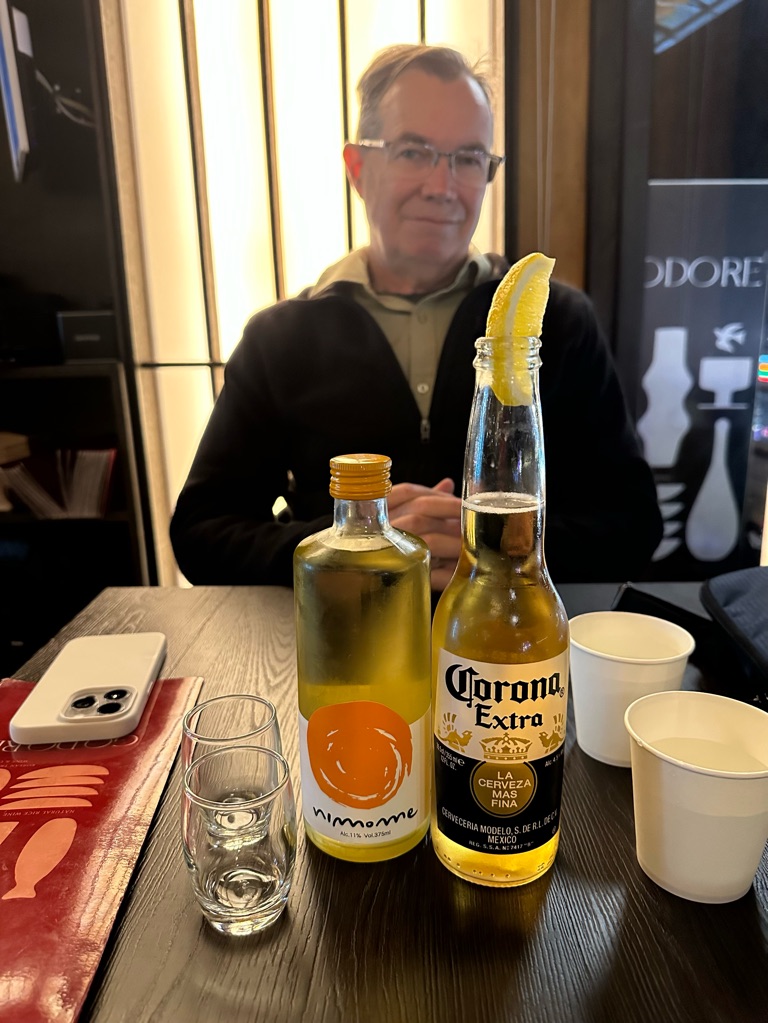
After traveling about 50 minutes, the bus dropped us off with about a 20 minute walk to the Golgusa Temple entrance. The Templestay program didn’t start until 4 but once checked in we donned the provided attire and rolled out our thin futons. We wandered to the top of the temple complex and climbed the steps to a Buddha carved into the hill somewhere between 600 and 900 AD. After an orientation on Buddhist practices we were put through a fairly strenuous hour of Soenmudo training- yoga-like exercises with additional twists. While still recovering we switched gears and did the 108 prostrations required in Buddhist practice. Can’t say we did quite that many, but it was close. Vegetarian dinner, back to our spartan room, and lights out by 9- not sure the temple life is for us.







We rose before 5 am to make it to the morning chants by 5:30. We weren’t told that the chanting included more prostrations- a lot more. We drug our aching bodies to breakfast to find that tea and coffee were not part of the plan. The odd breakfast with black beans, spicy potatoes, kimchi and rice would have to do. At 9 we went to another Soenmudo training that although less difficult than the previous one, our sore muscles could take little more punishment. Feeling adequately immersed in Buddhist culture we hit the Bodhi Tree Cafe just beyond the temple gates for coffee and “real” breakfast before making our way back to Gyeongju. We will miss this lovely city with these crazy mounds.





We boarded the bus in Gyeongju with no idea of where we would arrive in Busan, but we embarked at Busan Nopo train station in less than an hour and were at the hotel near Bujeon station in less than hour after that! Wandered about for food near Nampo then made our way to Gamcheon Culture Village. An old woman led us in the right direction and a sweet old man- a village ambassador- set us on a course to see the sites. Gamcheon is a beautiful collection of old buildings built into the hillside of a valley basked in late afternoon sun and in full festival celebration. Visitors and residents mingled about artists’ shops, cafes, and tourist stops including a “duck” cafe. Dined at a hipster chicken and beer place and found a chill craft beer bar after to finish the night. Busan is a clearly a nice place.





Last day in South Korea and we headed to an area popular with Koreans- Haeundae Beach. It was a beautiful day but not quite warm enough to lure anyone into the brisk waters. The area is full of activity with outdoor markets, festivals, biking, kite flying and more. Gleaming new mega-highrises dominate the skyline. You get some sense of the incredible size of Busan looking back from the shore, but can never take it all in with mountains slipping between neighborhoods. Wandering back towards the train we came upon some of the wildly costumed attendees of a large comic convention. No Marvel characters here as the Korean gaming world icons were the order of the day-Genshin Impact being a most popular option. So much to try and comprehend!








Spent the morning in Busan grabbing lunch before we boarded the ferry for Fukuoka. We arrived in Japan a little late and made our way on foot to the hotel. Opted for dinner at a busy izakaya near our hotel where the staff was friendly but there were no English menus or speakers so Google Translate it was. Ordering required marking the items yourself on a form provided-guessing which translations applied. Translations like “tree wiener” were not helpful. We ended up with 4 types of skewers-chicken with pickled plum, chicken with pollack roe foam, shishitos, and grilled fat. Didn’t know we ordered soup but it was delicious and the gyoza were good too. Fun start to our return to Japan.






Another beautiful day as we set off to see Fukuoka. Lovely city straddling a river and canals just a short way from the port. Clean streets, nice subways, and a surprisingly lovely underground shopping street. Finished the evening with dinner at a yatai- or outdoor food stand, which Fukuoka is famed for- and sake at a cute little sake bar. Made friends at both stops too.







Spent a relaxing day in Fukuoka, an easy place to chill. Lunched in a classic Hakata ramen spot on one of the many, narrow side streets that we discovered were full of activity. The Fukuoka Art Museum was a interesting stop with a special exhibit on giant robots which we didn’t even realize were of such cultural importance. Japanese gardens and a much needed outdoor foot massage rounded out the afternoon. After a huge plate of sashimi we ended our stay with a return visit to Kumorebi sake bar. Such a nice way to end a nice day.









Boarded a morning Shinkansen for Hiroshima arriving just an hour later. Hiroshima’s Peace Memorial Park, museums, and monuments is an internationally recognized site and it was busy with Japanese student groups and crowds of tourists from all over the world- the most non-Asians we have seen since we left LA. The museum exhibits are dramatic, graphic, and moving, focusing mostly on the impact of the atomic bombing although with relatively little mention of the events that led to that August day. Walking about this huge, vibrant city it is hard to imagine that it has largely been completely rebuilt over the last 78 years. Several students approached us to practice their English and record our thoughts on peace. Rounded out the day with Hiroshima’s famed okonomiyaki and sake of course.

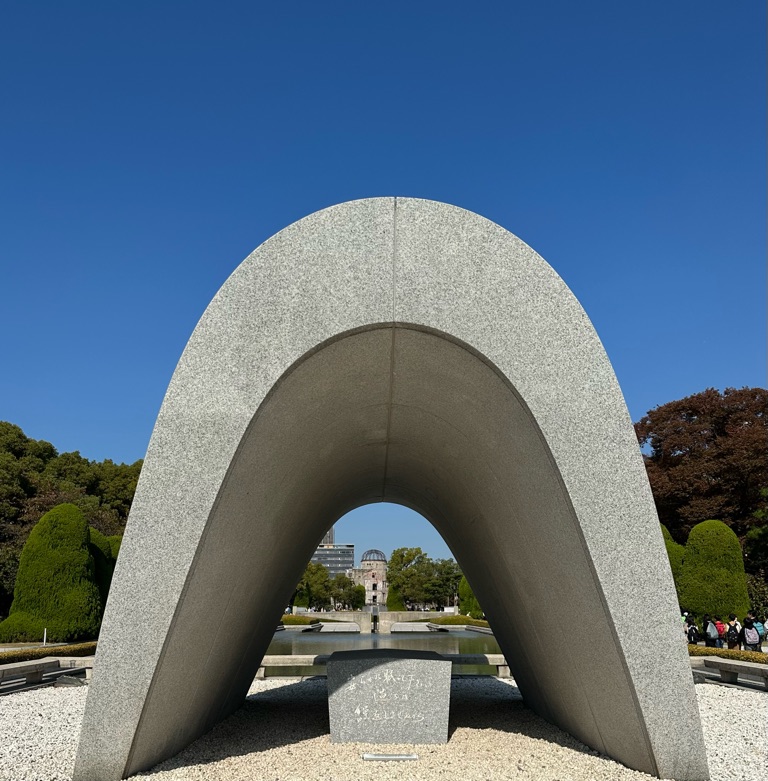





Takamatsu is on Shikoku Iskand, the last - and smallest- of the four main islands we will have visited on this trip. We arrived late afternoon but were able to catch the sunset over the Inland Sea. \240Nice feel to a city just a little larger than Cincinnati.




Stopped in Okayama to see one of Japan’s “Three Great Gardens”, Kōraku-en. The gardens, situated on an island in the Asahi River across from the Okayama Castle, date to the late 1600’s. Everything is meticulously manicured with laborers on hands and knees trimming edges and pulling weeds. The old castle forms a nice backdrop to garden views.



The now largely abandoned village of Nagoro is oddly populated by hundreds of handmade scarecrows. They appear to work the gardens, attend school, and live the lives of former residents in the 1980’s when the town was thriving with dam construction underway nearby. The local woman that creates the scarecrows rearranges them for the seasonal work at hand- planting, harvesting, cutting grasses- and adds scarves and hats as winter approaches.







Our guide met us at the Oboke station and we headed off into the Iya Valley. This is one of the more rugged and unsettled parts of Japan with road access only reaching most residents in the 1980’s and later in some places. Villages were once connected only by footpaths and vine bridges spanning the numerous valleys. Access is still not easy as the roads are steep and narrow with limited space for passing cars. Small villages step down the steep hillsides and cluster close to the generally one-lane road. The remaining vine bridges-although reinforced with cables - still make for an awkward crossing for the uninitiated.







Our room for the night in Oboke was a traditional Japanese style room complete with an outdoor soaking tub, an assortment of robes, and kaiseki style dinner. Some guests arrived for meals in the provided robes and slippers, but we stuck to our western gear. Mainly a travel day winding our way back to Okayama and then on to Osaka. After a much needed laundry time we celebrated our arrival in Osaka with some very non-Japanese snacks and local brew. Relaxing.






Osaka is home to Japan’s tallest building at only 60 stories, but the Abeno Harukas provided fabulous views of the vast sprawling metropolis. The nearby Shinsekai area is an old neighborhood of over-the-top signs, and streets filled with restaurants, shops, and arcades. As we ventured on we found dense shopping districts for electronics, cookware, and cosmetics. Continuing north we arrived at the famed Dotonburi area crowded with shoppers, tourists, and diners amid huge displays of lights and graphics. We managed to escape the crowds long enough to find a great dinner and a cozy bar.











This was our day for “old Osaka” starting with Osaka Castle - originally built in the late 1500’s and remodeled and rebuilt many times over the ages- it has two moats and rises above the surrounding gardens and neighbors on ramparts built of massive stones. The nearby Osaka Museum of History brought centuries of Osaka history to life in 4 floors of elaborate exhibits. The rain came, but was not enough to stop us as we dashed to a train station and wound our way to one of Osaka’s many covered shopping streets- the modern end to our day.








Nara was the capital of Japan in the 1700’s and as such it was filled with large temples, shrines, and gardens. Today it is a city about the size of Cincinnati with vast parks and wooded settings for the many shrines and temples…and thousands of deer! The deer are nearly domesticated and know to bow their heads to get a deer cookie (sold from stands everywhere). We obliged the deer with some cookies but nearly had to fight some of them away. Finished our stay on Osaka with a wonderful dinner at an izakaya- great food, and nice people too!









Long day traveling by subway, Shinkansen, highway bus, and another 1.5 km on foot (with bags) to arrive in Magome. Magome-juku was the forty-third of the sixty-nine stations of the Nakasendō trail connecting old Tokyo with Kyoto in the Edo period in Japan. Merchants, dignitaries, and war lords all traveled along this route stopping at inns, and paying homage at temples along the way. Our accommodations are once again traditional Japanese style with futons- no chairs- and a shared bath down the hall. Nice dinner and sake helped.






Draped in fall colors, we set out on a portion of the Nakasendo from Magome to Tsumago. The path winds up and down hills crossing over water, past shrines, and through villages several times. The path is mostly stone, sometimes dirt, and occasionally follows the road where the trail was being repaired. Ancient stone markers and newer wood sign posts mark the way. The Magome crossing was at about 2,600 feet and then we descended into Tsumago. The town has been faithful maintained and restored to the Edo period of the 1600’s giving a sense of what the travelers might have experienced. We lunched at a soba place in an old home with tatami mat floors before catching a bus back to Magome.

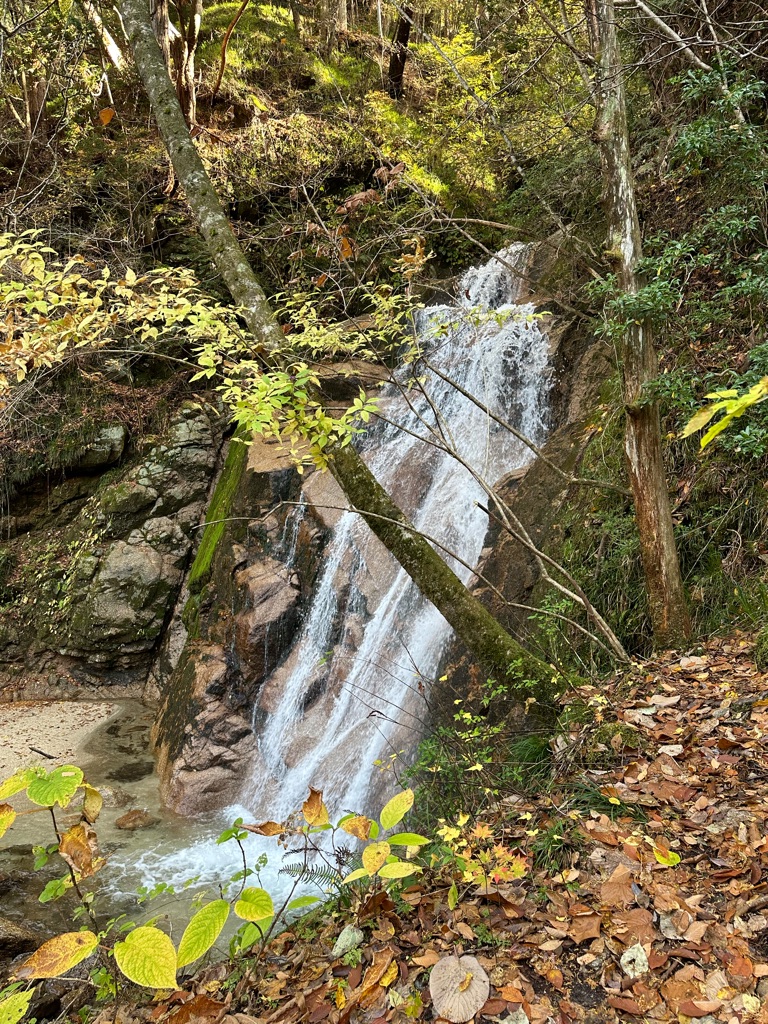


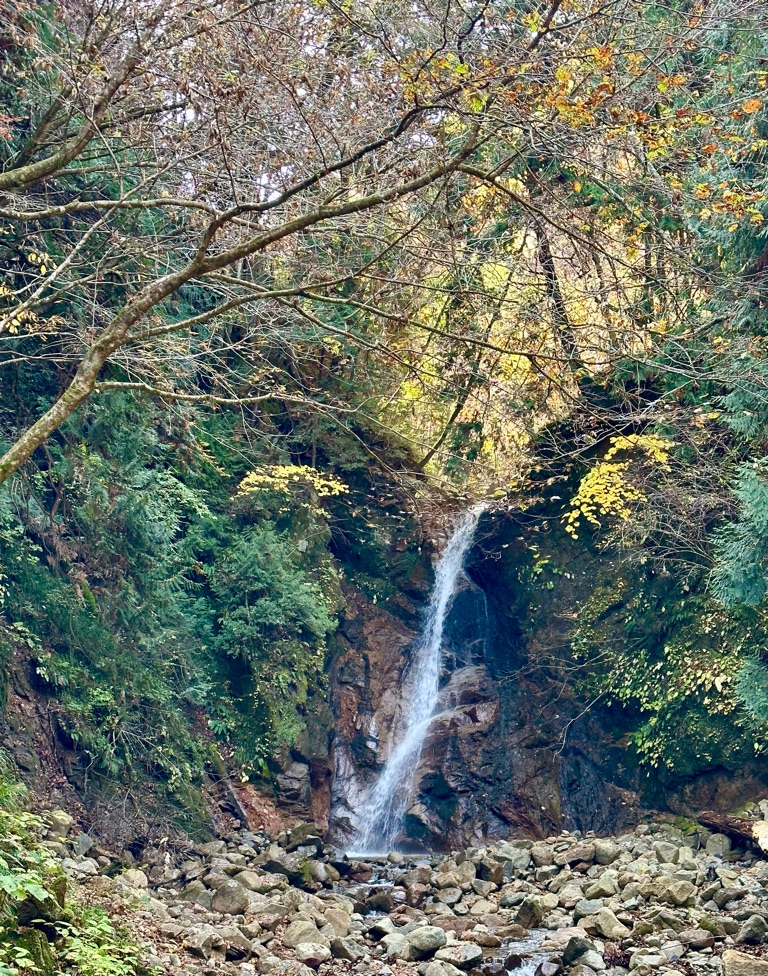



After our Japanese breakfast at the inn, we returned to Tokyo- in the rain- via bus to Nakatsugawa, train to Nagoya, and Shinkansen train to Tokyo. At Tokyo Station- one of the busiest stations in the world- we transferred to a JR local train to Koenji, where we will spend our last week. (Japan has 45 of the 50 busiest train stations in the world and all the top ten are in Japan!) Paul realized that since the apartment in Tokyo also has futons (not beds) that by the end we will have spent a third of the trip sleeping on the floor. Almost like camping. The neighborhood we are staying in is packed with very small restaurants and bars, some with room for only a few people. We had a lovely dinner at one and shared drinks and snacks at a couple more. A crusty old Japanese man that recalled visiting Cincinnati in the 80’s reminded us that Ohio sounds like good morning in Japanese. Fun place!





Well “ohayō” Asagaya! Coolest day yet, but no rain so after a leisurely morning at the apartment we took the train into Shinjuku. Crazy place but always fun. People were drinking “milk flights” at an outdoor event promoting Japanese dairy and a group of young singers was singing YMCA inJapanese. Found a great tsukemen ramen joint with counter seating for 12, crowded in and slurped up a delicious lunch. Squeezed into a small, smokey yakitori for dinner and finished with some sake and roasted taro at a little sake bar. Mostly just enjoying being in Japan today.






Chilly day, but good for visiting a couple of museums. The Sumida Hokusai Museum is dedicated to the late artist, Hokusai, whose work is nearly synonymous with Japan. His wave painting “The Great Wave off Kanagawa” is a national treasure. The Japanese Sword Museum displays some of the finest examples of Edo era samurai swords and explained the art of making these. These museums highlighted Japan’s rich heritage and artistic contributions. We parted with \240Japanese tradition for an authentic Turkish dinner and were even treated to olives by our new friend Saleh. (The olives were not on the menu)






Beautiful day in Tokyo which we started off at TeamLabPlanets- a bizarre immersive art experience. We wandered through rooms with thick cushioned floors, shin-deep water, mirrors and lights, a dome of flowers, huge balls, and hanging orchids. It was all accompanied by music selected for each experience. Shinjuku Gyoen National Garden rounded out a beautiful day.






Found our way to the Meiji Jingu gardens, shrine, and museum- passing through Shibuya and the old Olympic gymnasiums along the way. Another lovely day for a walk in the park.







We set off today for Asakusa in search of art and were not disappointed. We found a shop where a craftsman has been hand carving wood blocks for making replica prints of noted Japanese wood block art for the last 40+ years. He has also been training a young apprentice that carved the cherry wood for a print we purchased. Amazing detailed work that reminded us of the temple we visited in the Iya Valley surrounded by cedars. After, we wound our way to the National Museum of Art where wood block prints were, of course, on display. Finished the day with another delicious yakitori meal followed by wine and dessert with jazz music. Great day.



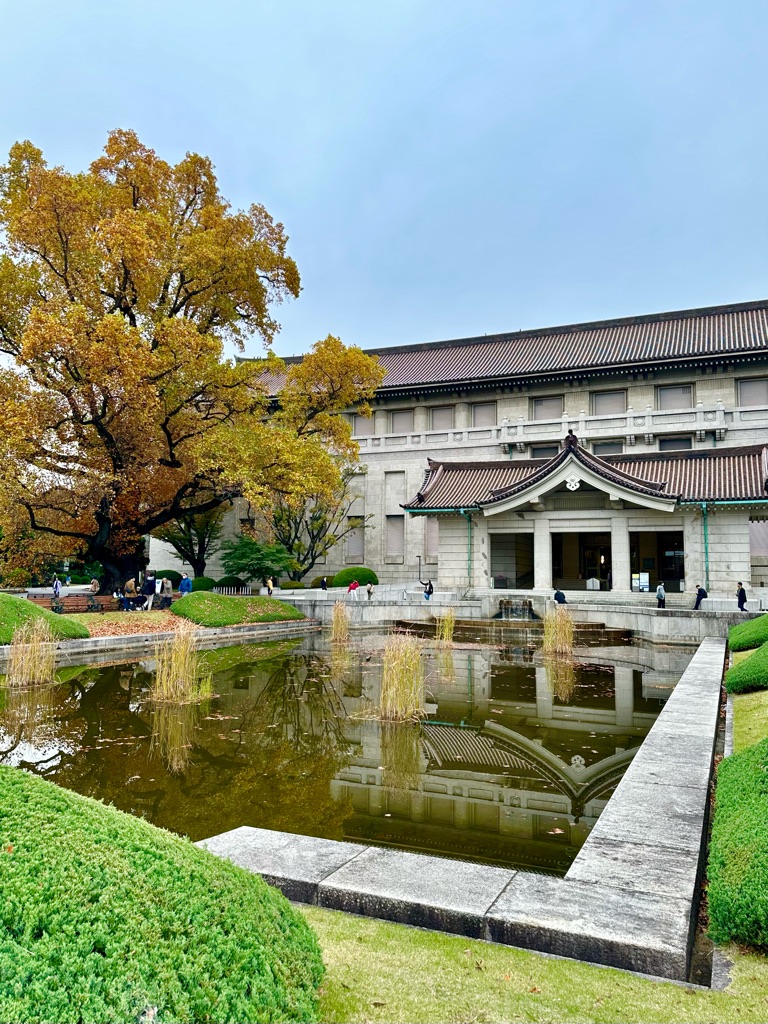


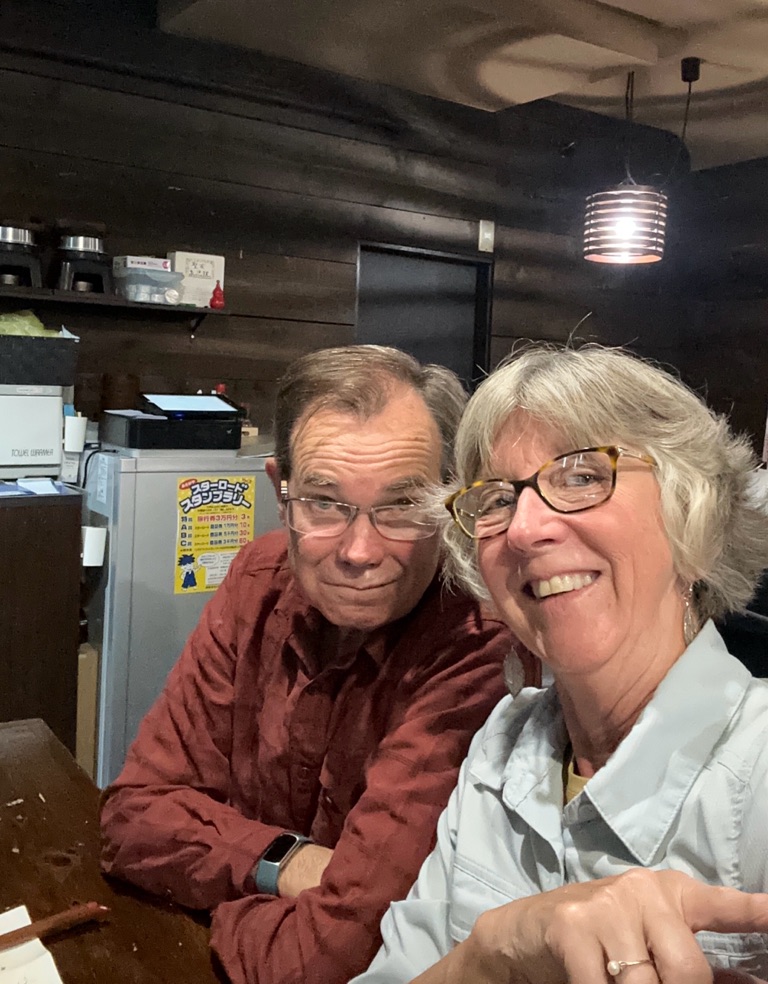
Last full day in Tokyo and we decided to investigate some new neighborhoods. Naka-Maguro is a lovely upscale neighborhood bordered by a cherry tree-lined canal with shops and restaurants strewn along its length. The area morphs into Maguro and eventually Ebisu, each increasingly more upscale and fashionable. A visit to the former home of one of Japan’s royal family- now a museum - confirms the neighborhood status. The former palace was an opulent art-deco home. Ended the day with a fabulous sashimi dinner and good conversation with locals and former locals. We will miss Asagaya.








Travel day, but still time for one last bowl of tsukamen ramen before we head to the airport. The dipping ramen restaurant Rokurinsha in Tokyo Station’s Ramen Street is well known and the line was an hour long-but we waited! Delicious or oishi as we say in Japan. Trains, planes, and lots of steps later and we are off. So much fun. I really hate to leave.








